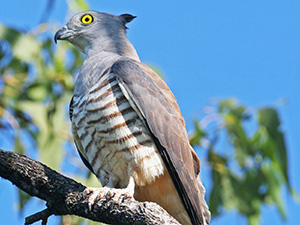The Cockatoos and Ravens are arch enemies, they sometimes have mid air battles. Incredible viewing. I’m yet to catch one with the camera.
This is something that seems beyond current science. How can such navigational ability be encoded in the birds’ DNA? Unless the older birds leave some sort of pheromone trail? (Birds don’t have a great sense of smell, so don’t think this is likely).
New Scientist article last year about the compass of migratory birds and speculation how they sense magnetic fields.
Birds seen on our 3 acre bush block in FNQ in the last few years:
Mistletoe bird
Leaden flycatcher
Noisy friarbird
Olive backed sunbird
Spangled drongo
Graceful honeyeater
Large tailed nightjar
Forest kingfisher
White throated honeyeater
Magpie lark
Bar shouldered dove
Laughing kookaburra
Black butcherbird
Peaceful dove
Rainbow lorikeet
Torres straight pigeon
Sulphur crested cockatoo
Brown goshawk
Grey goshawk
White bellied cuckoo shrike
Orange footed scrub fowl
Varied triller
Australian figbird
Brown cuckoo dove
Wedge tailed eagle
White Breasted wood swallow
Willie wagtail
Rainbow bee eater
Barking owl
Welcome swallow
Cicada bird
Australian brush turkey
Silver eye
Grey fantail
Rufous fantail
Yellow honeyeater
Dusky honeyeater
Emerald dove
Lovely fairy wren
Double eyed fig parrot
Olive backed oriole
Scaly breasted lorikeet
Spectacled monarch
Spotted pardolate
White breasted sea eagle
Metallic starling
Pied monarch
Little shrike thrush
Chestnut minnikin
Red browed fire tail
Scarlet honeyeater
Magnetic something something in the inner ear, I think?
That’s impressive. Many of those birds would never be seen around Melbourne, but there are quite a few on the list that you would see, especially in the Dandenongs.
These little guys ( brown thornbills I think ) were making a bit of a splash this morning in my backyard.
Yes that is how they navigate. You can imagine how if they have already been from somewhere they culd navigate back their using their internal satnav. But what I was talking about was how could they know how to interpret magnetic fields to navigate to a place they had never been before. Moreover, how could this be programmed into their DNA because that is all they are getting from their parents. So the “knowledge” of it must be somehow encoded in DNA, but how this could be done is not only unknown but hard to imagine how it could work.
It’s not smell, but something which identifies climate and land. The New Scientist article suggested something built into the eye and perhaps intensity of light.
You are still missing the point, so I will leave it at that.
no blue eyed honeyeaters ?
I get it. Mrs Fox and I argue over characteristics passed down from parent etc. She cites many studies that postulate memories are embedded in genetic materials and passed to next generations. No reason why birds shouldn’t do the same. Interesting field of study.
If you think so
I do happen to know a thing or two about genetics, especially of complex traits (a field which is too difficult for most geneticists to tackle successfully). I don’t know of any reliable study that has established memories being encoded in DNA rather than learned. There are reports of “physiological memory” being transgenerational but they are controversial, and anyway that is a different issue and may be mediated by preferential methylation. It is hard to see how such a mechanism would have enough precision to mediate accurate migration over thousands of miles.
That is my argument vs Mrs Fox. She is a psychotherapist, psychologist and probably was an Egyptian Priestess in a previous life. And never wrong.
However I have looked at the psycho-babble research she quotes, and it is done at prestigious Universities in US and Europe and is peer reviewed. Not that means that much anymore, when you see some of crap coming out of University these days. Somehow fact and fiction becomes a blurred line.
There is always the survival instinct - learned experience of food water, shelter ( temperature related): signposts to where it can be found.
I think they’re Striated Thornbills. Got that reddish cap and stripier face. I don’t notice them often because they’re usually near the canopy, whereas Brown Thornbills are usually within a few metres of the ground.
They are in more drier places like Townsville and the Atherton tablelands.
I also forgot the beach stone curlew , once you hear their cries at night you won’t forget it. In the Tiwi islands there are old indigenous stories of them carrying the souls of dead babies, hence the crying at night



